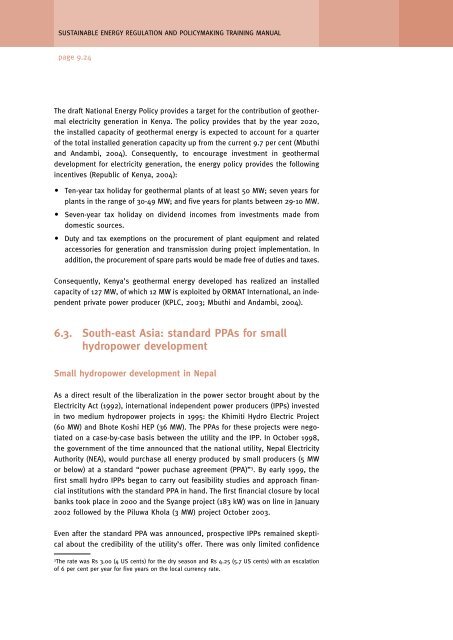Regulatory and policy options to encourage development of ...
Regulatory and policy options to encourage development of ...
Regulatory and policy options to encourage development of ...
- No tags were found...
You also want an ePaper? Increase the reach of your titles
YUMPU automatically turns print PDFs into web optimized ePapers that Google loves.
SUSTAINABLE ENERGY REGULATION AND POLICYMAKING TRAINING MANUALpage 9.24The draft National Energy Policy provides a target for the contribution <strong>of</strong> geothermalelectricity generation in Kenya. The <strong>policy</strong> provides that by the year 2020,the installed capacity <strong>of</strong> geothermal energy is expected <strong>to</strong> account for a quarter<strong>of</strong> the <strong>to</strong>tal installed generation capacity up from the current 9.7 per cent (Mbuthi<strong>and</strong> Andambi, 2004). Consequently, <strong>to</strong> <strong>encourage</strong> investment in geothermal<strong>development</strong> for electricity generation, the energy <strong>policy</strong> provides the followingincentives (Republic <strong>of</strong> Kenya, 2004): Ten-year tax holiday for geothermal plants <strong>of</strong> at least 50 MW; seven years forplants in the range <strong>of</strong> 30-49 MW; <strong>and</strong> five years for plants between 29-10 MW. Seven-year tax holiday on dividend incomes from investments made fromdomestic sources. Duty <strong>and</strong> tax exemptions on the procurement <strong>of</strong> plant equipment <strong>and</strong> relatedaccessories for generation <strong>and</strong> transmission during project implementation. Inaddition, the procurement <strong>of</strong> spare parts would be made free <strong>of</strong> duties <strong>and</strong> taxes.Consequently, Kenya’s geothermal energy developed has realized an installedcapacity <strong>of</strong> 127 MW, <strong>of</strong> which 12 MW is exploited by ORMAT International, an independentprivate power producer (KPLC, 2003; Mbuthi <strong>and</strong> Andambi, 2004).6.3. South-east Asia: st<strong>and</strong>ard PPAs for smallhydropower <strong>development</strong>Small hydropower <strong>development</strong> in NepalAs a direct result <strong>of</strong> the liberalization in the power sec<strong>to</strong>r brought about by theElectricity Act (1992), international independent power producers (IPPs) investedin two medium hydropower projects in 1995: the Khimiti Hydro Electric Project(60 MW) <strong>and</strong> Bhote Koshi HEP (36 MW). The PPAs for these projects were negotiatedon a case-by-case basis between the utility <strong>and</strong> the IPP. In Oc<strong>to</strong>ber 1998,the government <strong>of</strong> the time announced that the national utility, Nepal ElectricityAuthority (NEA), would purchase all energy produced by small producers (5 MWor below) at a st<strong>and</strong>ard “power puchase agreement (PPA)” 3 . By early 1999, thefirst small hydro IPPs began <strong>to</strong> carry out feasibility studies <strong>and</strong> approach financialinstitutions with the st<strong>and</strong>ard PPA in h<strong>and</strong>. The first financial closure by localbanks <strong>to</strong>ok place in 2000 <strong>and</strong> the Syange project (183 kW) was on line in January2002 followed by the Piluwa Khola (3 MW) project Oc<strong>to</strong>ber 2003.Even after the st<strong>and</strong>ard PPA was announced, prospective IPPs remained skepticalabout the credibility <strong>of</strong> the utility’s <strong>of</strong>fer. There was only limited confidence3The rate was Rs 3.00 (4 US cents) for the dry season <strong>and</strong> Rs 4.25 (5.7 US cents) with an escalation<strong>of</strong> 6 per cent per year for five years on the local currency rate.










